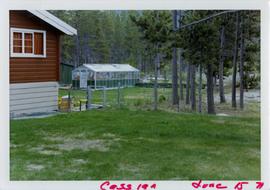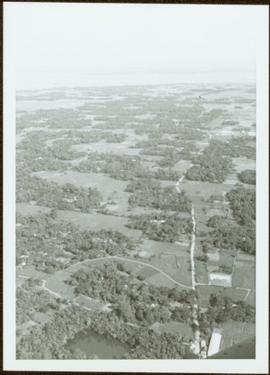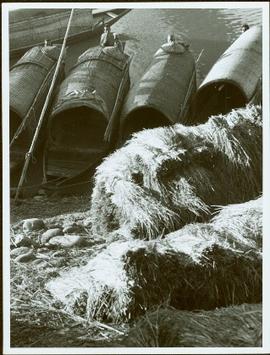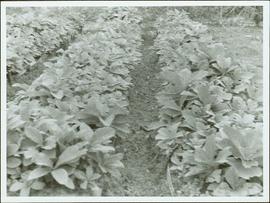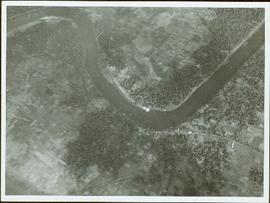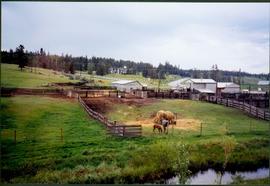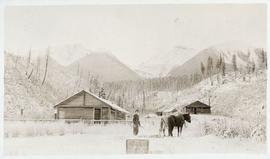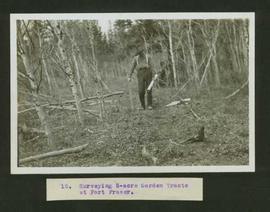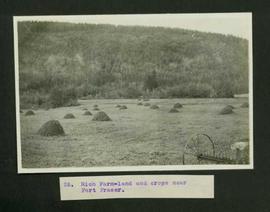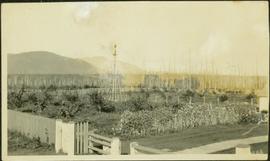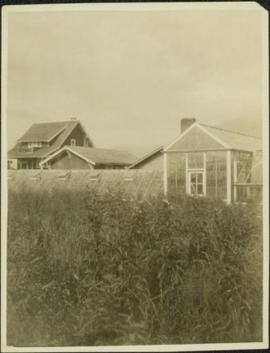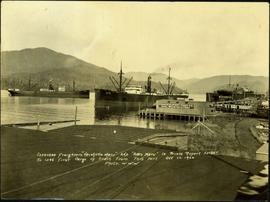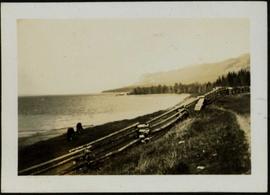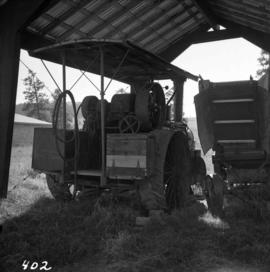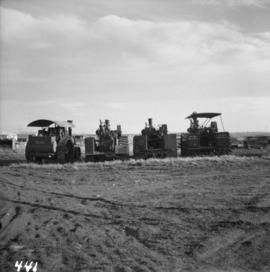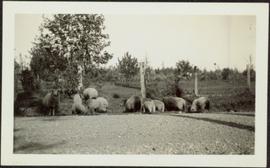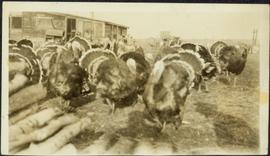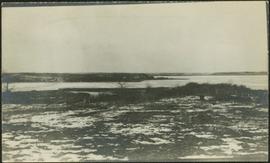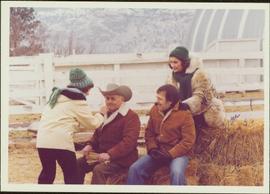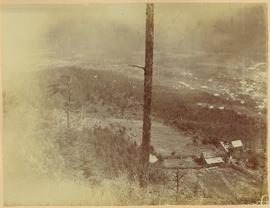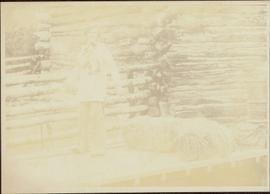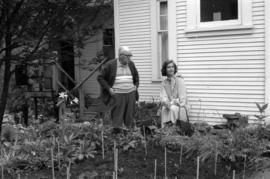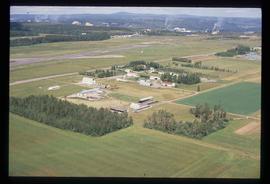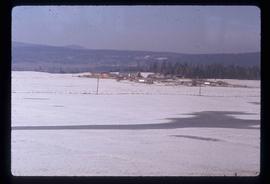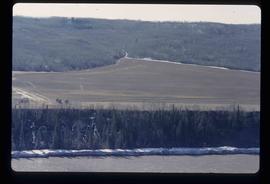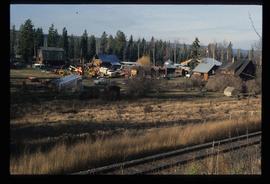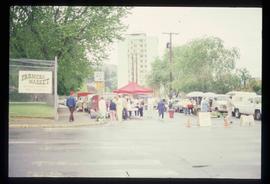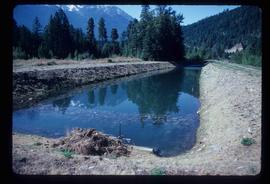Photograph depicts part of a brown and white building similar to the "Director's Lodge" at Cassiar, B.C. (see items 2000.1.1.3.19.88 and 2000.1.1.3.19.89). Unidentified individuals visible inside greenhouse in fenced back yard. Forest in background. Handwritten annotation on verso of photograph: "Cassiar June 15 71".
Item is a photograph of forests and farms from the air.
Item is a photograph of boats docked on the shore behind piles of grain or straw.
Item is a photograph of rows of plants in a garden.
Item is a photograph of a river bend and the surrounding country taken from the air.
Photograph depicts two horses in one of many fenced areas, buildings and machinery in background. Highway, house, and forest also visible in distance.
Sign in photograph appears to read "Mile 33, BC" and "Can (?) Press Prepay".
File consists of material created or collected by Audrey L'Heureux regarding agriculture and weather in British Columbia. Highlights include:
- BC Department of Agriculture, "Agriculture in the North Cariboo and Central British Columbia", 1969 (booklet)
- BC Department of Agriculture, "Agriculture in the North Cariboo and Central British Columbia", 1974 (booklet)
- William Gilgan, "Agriculture in the Regional District of Bulkley-Nechako", 1972 (booklet)
- Alastair McLean, "History of the Cattle Industry in British Columbia", Rangelands 4 (3), 1982 (journal article)
- Fritz Dalchow, "Agricultural Geography of British Columbia, 1972 (book)
- Kemano Completion Hearings, "Potentials for Agricultural Irrigation Return Flows and Nutrient Runoff and Leaching", 1994 (document)
File consists of an inaugural Summer 1993 issue of a newsletter from the Seedy 2000 Club of Vanderhoof about heritage seeds.
Item consists of transcript of interview with Bob Dunsmore, CNC Forestry Dean who discusses forestry and agriculture education at College of New Caledonia.
Harkins, BobItem consists of interview with Mabel Peterson who discusses domestic, family life and community life in small communities in North Central British Columbia c.1920s-c.1970s.
Harkins, BobTyped caption glued to album page directly below photograph reads: "15. Surveying 5-acre Garden Tracts at Fort Fraser." Photograph depicts a man holding a rolled map in one hand and a wooden stake in the other, standing in a wooded area. Photographer: Dominion Stock & Bond Corporation.
Typed caption glued to album page directly below photograph reads: "26. Rich farm-land and crops near Fort Fraser." Photograph depicts hay stacks in a field situated at the base of a small forested mountain. Photographer: Dominion Stock & Bond Corporation.
Typed caption glued to album page directly below photograph reads: "34. Rhubarb near Fort Fraser." Photograph depicts a close up of a crop of rhubarb. Photographer: Dominion Stock & Bond Corporation.
Photograph depicts young fruit trees planted in fenced area with small wind mill, hills in background. Handwritten annotation on recto of photograph: "This is part of the fruit trees if you place it along side of the other one you can see the location the farm buildings are on the other side I didn't get one of them."
Greenhouses stand in front of house in field, hills in background.
Handwritten caption along bottom of photograph reads: "Japanese freighters 'Yeiufuku Maru' and 'Aden Maru' in Prince Rupert Harbor to load first cargo of grain from this port, Oct. 22, 1926. Photo W.W.W." The Prince Rupert Feed Co. Coal, Grain, Hay & Feed Company building visible from Trotier's Dock.
Photograph depicts two horses grazing behind log fence along the beach of Stuart Lake. Forested peninsula and distant hills are visible in background. Handwritten photo caption below photograph reads: "Stuart Lake, BC".
Photograph depicts a traction engine at a ranch on Nicola Lake, near Merritt. The engine was made by Nichols-Shepard Co. at Battle Creek, Michigan and named the "Red River Special." It is undated and has 2 cylinders, side tanks, 16-10 horse power, wood burner, firebox 5 ft. long.
Photograph depicts a rear view of 4 of the 6 traction engines in Nanton, Alberta. The left engine was built by Reeves and Co. in Columbus, Indiana, U.S. Its identification is #4438, it has 2 cylinder simple, and a roof. The next engine was built by Waterloo Mfg. Co. Ltd. in Waterloo, Ontario and has a single cylinder. The third engine was built by Sawyer Massey. The engine on the right side is a Gaar Scott, built in 1913, and has 25 horsepower on the drawbar and 75 horsepower on the belt.
Herd of sheep grazes in ditch. Gravel road in foreground, fence and trees in background.
Firewood pile in left foreground. Buggy, wood house, and porch in background. Handwritten annotation on recto of photograph: "Wishing Aunt Lillian + Uncle Alan a very Merry Xmas and Happy New Year. Please do not criticize the stitches too closely Aunt Lillian. These snaps are some of part of my flock of 102 this year. These were snapped about a week before Thanksgiving. All the birds you see are this year's hatch. Some of them dressed 17 1/2 + 18 lbs at Thanksgiving. With love from Jean."
Photograph depicts snowy area speculated to be a farm yard in foreground. Frozen water crosses midground, opposite shore in distance.
Signature at bottom right corner reads: “Love you always! Merv”; handwritten annotation on verso reads: “Hon. P.A. ‘Flying Phil’ Gaglardi on his Ranch near Kamloops. CBC Show 1981, One of a Kind, Picture from Producer Friend Merv Compone”.
Landscape featuring town buildings below on right. A farmyard can be seen in foreground.
Photograph depicts Iona Campagnolo sitting and talking with an unidentified man in a home garden in Prince Rupert.
Image depicts a view of an experimental farm, possibly taken from Tabor Mountain.
Image depicts a farm at an uncertain location.
Image depicts what is possibly the Peace River running next to some farm land at an uncertain location.
Image depicts a farm likely in Woodpecker, B.C.
Image depicts a street, possibly in Kamloops, which has been closed for a Sunday morning Farmer's Market.
File consists of a transcript of an oral history interview with Jack and Sarah Marsh.
Image depicts what is possibly an irrigation channel somewhere in Seton Portage, B.C.
Series consists of records relating to G. Gary Runka's personal life, including academic records, personal resume, and posthumous materials. Also includes Runka's personal correspondence during his time with the Agricultural Land Commission and memorabilia from his curling activities.
File consists of a copy of Gary Runka's resume prior to the creation of his consultancy business G. Gary Runka Land Sense Ltd.
File consists of G. Gary Runka's high school records.
File consists of a 1955 North Peace High School yearbook.
File consists of two Peace River District High School Curling Championship patches.
File consists of a speech given by Gary Runka to the Agricultural Institute of Canada Land Use Committee entitled "Land Use Control and Jurisdictional Rights".
Commentary on this speech by Barry Smith of the Ministry of Agriculture and Lands:
"This is a first draft position paper written by GGR was developed for the Agricultural Institute of Canada, Land Use Committee.
The paper notes that attitudes are shifting from land being considered as a commodity to considering land as a natural resource. There are several references to governmental relationships, the inability to count on local governments to preserve agricultural land and the need for a federal land use policy supporting farmland preservation.
The use of a zoning tool as an effective means to preserve agricultural land is explored. The paper makes a strong case for there being no legal need for compensating land owners for regulatory land use zoning.
Included with the package are two letters written by GGR (November 7,1974) sent to Jim Lore (Alberta) and Steve Hart (Ottawa) requesting their review of the paper and input. A copy of the finalized paper, which may have been a jointly authored paper, is not included and it is not known if the paper was eventually published by the Agricultural Institute of Canada."
File consists of notes written by Joan Sawicki for an untitled pending speech by Gary Runka.
Commentary on this speech by Barry Smith of the Ministry of Agriculture and Lands:
"Despite this being only 4 pages of rough notes, its focus on the initial work of the Commission and challenges of designating the ALR make it an historically important document.
For example it was initially thought the ALR would be guided by class 1 - 4 CLI ratings but this proved impractical in the north and range areas. An additional challenge was that parts of the province only had the benefit of 1:50000 mapping. This presented a very real problem for establishing the ALR.
One concern with this document is that because it is written in point form and consists of rough notes, it could be open to a degree of misinterpretation if not considered by an individual with experience in the administration of the ALR. For a much more refined statement on the B.C. Agricultural Land Preservation program and the designation of the ALR see Items [2020.4.2.1.23, 2020.4.2.1.24, and 2020.4.2.1.25]."
File consists of a speech given by Gary Runka to the B.C.I.A. entitled "Agricultural Land Reserves and the Land Commission Act".
Commentary on this speech by Barry Smith of the Ministry of Agriculture and Lands:
"With the original package associated with this speech are 5 pages of rough notes for another speech with the same title prepared for a B.C.I.A. meeting on March 22, 1976... Given that these rough notes were held with the material associated with the April 15, 1976 meeting it is possible the B.C.I.A. meeting planned for March was shifted to the April date. Additionally there are 6 pages numbered 6-11 that are of some detail concerning the work of the Commission but appear to be part of another speech but are included with the B.C.I.A. package and have, therefore, been [included with this speech].
The title of the speech "Agricultural Land Reserves and the Land Commission Act" sums up the thrust of the speech which notes the objectives of the legislation, the Commission's program of land acquisition and Commission research and support of innovative projects to assist rural planning to create a positive environment for agriculture and give direction to urban growth away from farmland.
Additionally an overview is provided of the Commission's activities in its first two years of operation. GGR comments that establishing the ALRs "... was but a first step and we feel that it is our job to continue to protect the Reserve by whatever approaches and methods of rural planning that are available to us". This speaks to a Commission that saw its role, even at this early stage, as being much more than simply a rationing board reviewing ALR applications.
Several examples are outlined in which it is suggested that professional agrologists should be looking at carefully.
At the end of the speech (p.5) GGR includes (a note to himself) to "follow with example of an agrologist's public statement" that obviously was of concern. The actual public statement was not included with the speech given on April 15th but was included in the rough notes of the speech dated March 22 which read as follows:
"Yet a member of the B.C.I.A. - a P.Ag - is quoted in the press in response to a local politician who asked him a question something like this in regard to an ALR exclusion application:
Local politician: What about the international, national and local concerns regarding land for future food production?
BOA member P.Ag: We should firstly be concerned with places for people to live and secondly worry about land for food production.
This is our profession - the image is yours to make.
I don't mean that we should go overboard, but if we are not willing to defend preservation of agricultural land - who is?"
File consists of notes for an untitled speech about "Experiences at the B.C. Land Commission" by Gary Runka at a Habitat 1976 panel at the United Nations Conference on Human Settlements, Vancouver between May 31-June 11,1976.
Commentary on this speech by Barry Smith of the Ministry of Agriculture and Lands:
"GGR gave this speech as part of a panel at Habitat 1976.
The speech outlines the scope of the legislation, background of a provincial zoning technique (based on technical information), the establishment of the ALR plans in each of 28 regional districts and commentary on some of the projects the Commission is involved with.
Providing context to the land-use planning environment that the B.C. farmland preservation program and ALR were thrust into in the mid-1970s, GGR remarks that:
"In many cases we have local governments making their first real strong attempt at land use planning. Backed by the strength of the Land Commission Act it is seen as a real change to control urban sprawl and linear development that is detrimental from other planning points of view, as well as from the agricultural land point of view."
The fact that GGR was asked to be part of the panel at the first United Nations Conference on Human Settlements speaks to the regard given the B.C. farmland preservation program."
File consists of a speech given by Gary Runka entitled "Vegetable Situation in BC".
File consists of an untitled speech to the Chilliwack Chamber of Commerce regarding land use planning and its impact on the food producer.
Commentary on this speech by Barry Smith of the Ministry of Agriculture and Lands:
"These 3 pages of notes prepared for a speech given to the Chilliwack Chamber of Commerce are packed with several important themes and is a more refined version of [2020.4.2.1.24].
Some of the important themes mentioned include:
- Preserving the option of agriculture in BC will not be accomplished by preserving agricultural land alone;
- Prior to the ALR we were losing our best farmland first;
- BC is attempting to become more self-sufficient in food production;
- BC agriculture is diverse but lacks large volumes of any single commodity;
- Rural areas must be carefully planned to protect food production and not thought of as a storehouse of future urban development;
- With land use planning it is often difficult to see benefits in the short term but losses for a few people should amount to long term gains for many; and
- Several examples are provided of initiatives aimed at protecting rural areas, habitat etc.
The speech notes include the first mention of the work of the Ministry of Agriculture's Greenzone Committee and its efforts to find ways of reducing land use conflicts.
Many of these themes have been considered in previous speeches but are consolidated here and the paper ends with a need for food producers to get involved in land use planning process."
File consists of a speech given by Gary Runka entitled "Private Land Needs and the BC Agricultural Land Commission Experience" for the Perspectives on Natural Resources Symposium II at Sir Sanford Fleming College in Lindsay, Ontario.
Commentary on this speech by Barry Smith of the Ministry of Agriculture and Lands:
"This represents a major, out of province speech. It covers some familiar historic themes concerning the implementation of the BC farmland preservation program but also provides other interesting insights. It includes an informative summary of the land scarcity problem particular to BC.
With the designation of the ALR complete, the much more difficult task is: "... to make the right land-use decisions within the agricultural zone and encourage good land use planning adjacent to it in order to accomplish the stated objectives." This statement clearly establishes the perspective that the ALC is not just focused on land within the ALR but believes its protection mandate extends beyond the bounds of the Reserve.
GGR states that for competing uses there are normally non-agricultural alternatives but: "...the ability and willingness to go in these other directions necessitates a radical change in thinking on the part of governments, private industry, real estate interests, and the general public." Fourteen competing land uses are noted.
It is noted that the ALC Act "...has provided impetus for more formal planning at the local and regional levels..." - a fact all too often missed.
GGR reviews the types of plan policies that will assist the preservation of farmland and support the continued farming of agricultural land.
A number of specific initiatives are noted and mention is made of the urban / rural fringe problems and the work of the Ministry of Agriculture Green Zone Committee. Mention is made of the challenges associated with dealing with conflicts with other provincial and federal agencies.
The paper is summarized with three general approaches to looking at land needs, land uses and resource planning drawn from GGR's personal experience:
- Canada can't afford many more mistakes in the area of land resource allocation and making land-use decisions on the basis of the land's inherent natural characteristics is more reliable and sensible than based on the protection of property values and simply accommodating growth pressures;
- The ALC has learned that every move in rural planning and every decision in resource management has impact upon agriculture; and
- Agricultural land preservation represents a provincial priority and it has identified a direction around which all others can plan.
GGR closes - "In the final analysis, it is the process of planning that is important, the product itself is never quite finalized."
File consists of a speech given by Gary Runka entitled "The BC Agricultural Land Preservation Experience" to the Canadian Agricultural Extension Council Conference in Kelowna.
Commentary on this speech by Barry Smith of the Ministry of Agriculture and Lands:
"This speech represents a major paper that reiterates historical themes concerning the legislative initiative, B.C's very limited area available for agricultural production and the designation of the ALR plans.
GGR emphasizes that the main criteria when considering applications under the ALC Act is the soil/climate capability for agriculture. He mentions that the actual designation of the ALR and its subsequent refinement was fairly straight-forward but: "Much more difficult is the task that we are now facing, to make the right land-use decisions within the agricultural zone and encourage good land-use planning adjacent to it in order to accomplish the stated objectives."
GGR remarks that the ALC Act is based on the assumption that there are alternatives to farmland for urban uses and he personally agrees that alternatives do exist in almost all cases but he cautions: "But, the ability and willingness to go in these other directions necessitates a radical change in thinking on the part of governments, private industry, real estate interests, and the general public. It also demands an acceptance of the fact that agricultural land preservation is in British Columbia to stay and it assumes a commitment to preserve the agricultural industry as being in our own long term best interests. Some vibrations tell me we still have not quite made the grade in this area." These words were spoken by the Chair of the ALC 36 years ago and could be as appropriately be spoken by any of the subsequent ALC's Chairs to this day.
Competing land uses are listed and guidelines on expected policy content in Official Settlement Plans developed under the Municipal Act aimed at the protection of agricultural land and agriculture are noted.
Three examples are provided of studies to explore alternate areas of growth along with work on dealing with impact issues (edge/interface planning). GGR emphasizes the challenge of dealing with other governmental agencies and ends by outlining 3 general approaches to look at land needs, land uses and resource planning:
- Make land use decision based on the inherent natural characteristics rather than protecting land values or simply accommodating growth;
- The Fall 1977 amendments to the Act allowing greater Cabinet involvement will test the program but also emphasizes the importance of shared decision making; and
- The ALC Act has defined a land use priority and a direction around which all others can plan and there is a need for a national land use policy that GGR supports."
File consists of a speech given by Gary Runka entitled "BC Experience: Establishing Priorities for the Use of Rural Land Resources" for the Canadian Institute of Planners Annual Conference in Kitchener, Waterloo.
Commentary on this speech by Barry Smith of the Ministry of Agriculture and Lands:
"This is a second speech GGR gave at the 1980 CIP Conference.
The 'rural' stage is set by stating that BC is 94% crown land of which 53% is unreserved crown land - so lots of rural land to plan for.
The paper largely outlines 8 examples of rural land use priorities in BC including:
- Integrating rural land use policy under the Environment and Land Use Act
- Agricultural Land Commission Act protecting farmland
- Forest and Range Act
- Municipal and Regional government community, settlement and regional plans - largely on non-crown land
- The Federal government's amended Fisheries Act
- Special Statutes Planning - The Islands Trust Act
- Crown land Planning Strategies
- Environment Planning via an Environment Act, Water Basin Plan and Wildlife along with complimentary legislation.
The paper helps to place the farmland preservation in the context with other land use planning efforts in British Columbia."
File consists of a speech given by Gary Runka entitled "Who Gets to Use the Land and Water? - the Urban and Agricultural Land Needs of the Okanagan Valley" for the Faculty of Agricultural Sciences, UBC and Okanagan College.
Commentary on this speech by Barry Smith of the Ministry of Agriculture and Lands:
"Although the ALR and ALC Act are not mentioned directly, the paper is focused on agriculture and rural planning.
When speaking of the competition for land and the pressure agricultural land is under, an interesting statement is included referring to the fact that "the fluctuation" in Washington State's apple crop is greater than the entire annual Okanagan production.
The paper reviews pressures on agriculture and urban land uses. Under "Satisfying the Needs (Options and Interrelationships)" seven points are made including "Understanding the land is the most important prerequisite to its wise and proper use," and that Integrated Natural Resource Management and Land Use Planning must be closely tied.
The paper ends with a point of optimism - "I see that potential to increase our understanding of the natural processes and to explore the questions of who gets to use the land and water from a view point somewhere in the orchard or countryside rather than from Main Street. That's a beginning."
File consists of a speech given by Gary Runka entitled "Planning for the Future Agricultural Land Base of Alberta" for Alberta Agriculture Land Use Activities, Edmonton, June 2,1981.
Commentary on this speech by Barry Smith of the Ministry of Agriculture and Lands:
"This appears to be a set of preliminary speaking notes - much of it is point form with considerable hand written notes in the margins. It is not known if these notes were ever finalized into the speech given on June 2,1981 or if the speech was simply given using these notes as its basis.
Many of the references are somewhat oblique relating to topical matters in Alberta. While agriculture is the central theme, this speech is focused on Alberta with little or no reference to the BC farmland preservation program.
Several broader themes are considered which are dealt with in other speeches but GGR speaks to the longer term importance of farmland preservation legislation when stating (p. 3):
"b) from my experience, time is demonstrating ever more clearly to me that, for a variety of reasons, legislating land preservation alone can only hold the land resource for so long if the other aspects affecting the food producing industry are not also given attention e.g.:
- review of regional planning by the ARB
- costs of production and marketing opportunities
- gov't priority for ag. related to other prov. resources
- urban planning - where are the cites going?
- rural planning - how secure are the rural communities of which agriculture is a part?"
